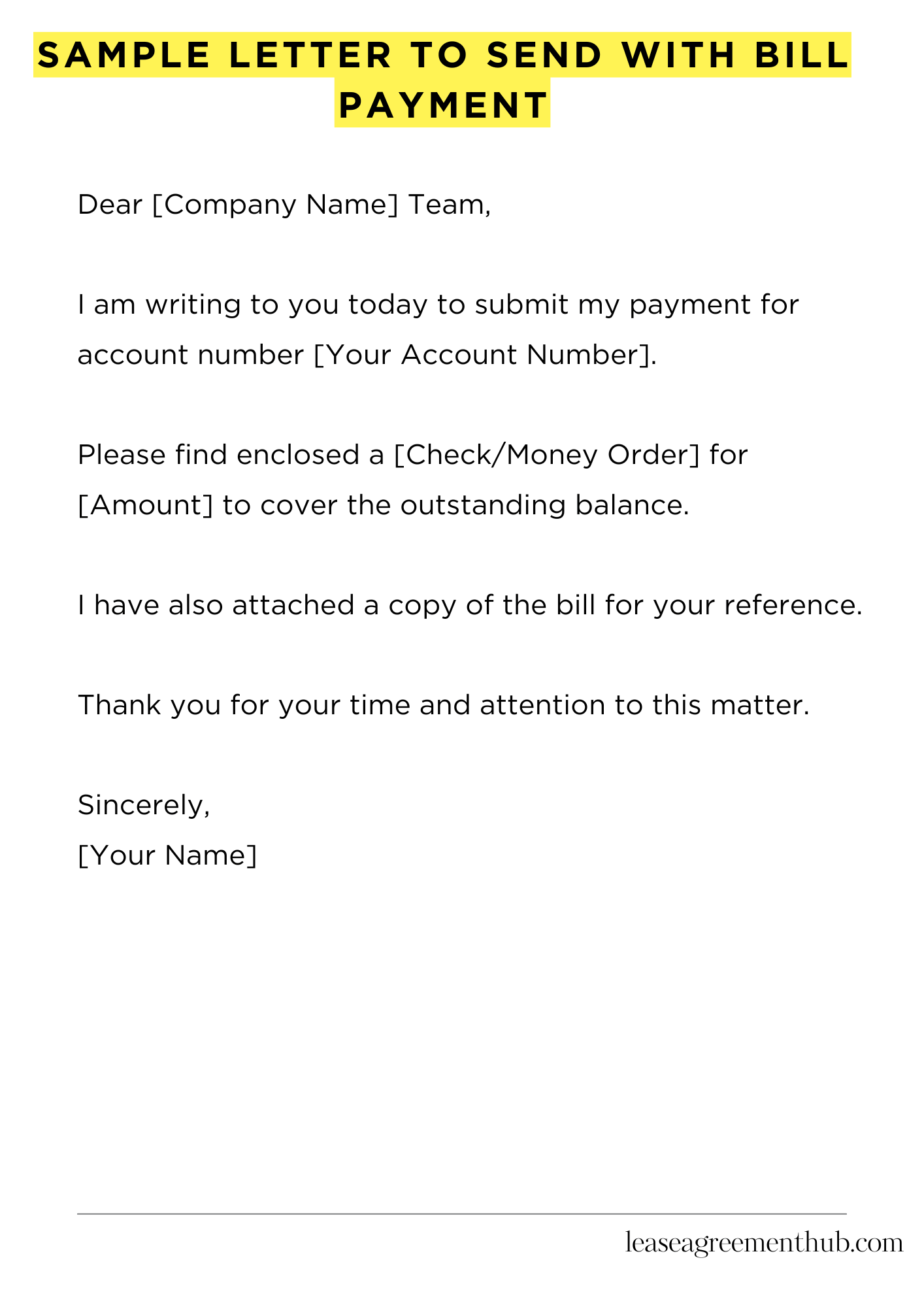Need to send a payment but want to add a note? A “Sample Letter To Send With Bill Payment” is just what you need. It’s a short letter you send with your payment. Use it to explain why you’re paying, or if there’s a problem.
Writing letters can be hard. Especially when you’re dealing with payments. That’s why we’re here to help.
We’ve got templates and samples ready for you. These will make writing your payment letter easy. Let’s get started!
Sample Letter To Send With Bill Payment
[Your Name]
[Your Address]
[Your Phone Number]
[Your Email Address]
[Date]
[Company Name]
[Company Address]
Subject: Payment for Account [Your Account Number]
Dear [Company Name] Team,
I am writing to you today to submit my payment for account number [Your Account Number].
Please find enclosed a [Check/Money Order] for [Amount] to cover the outstanding balance.
I have also attached a copy of the bill for your reference.
Thank you for your time and attention to this matter.
Sincerely,
[Your Name]

How to Write Letter To Send With Bill Payment
Subject Line: Brevity is Key
- Keep it concise. A subject like “Payment Enclosed – [Account Number]” is often sufficient.
- Avoid overly verbose or intricate constructions; clarity trumps ornamentation here.
- Remember, the goal is immediate identification – think utilitarian, not artistic.
Salutation: A Touch of Professionalism
- Address the recipient formally, if possible. “Dear Accounts Payable Department” or “Dear [Company Name]” works well.
- If you know a specific contact person, by all means, employ their name. It adds a personal touch.
- Avoid overly casual greetings. This isn’t the time for “Hey” or “Hi Folks!”
Body: The Meat and Potatoes
- Start by clearly stating your purpose: “Please find enclosed payment for invoice [Invoice Number].”
- Specify the payment amount and the method of payment (check, money order, etc.). Precision is paramount.
- Include your account number and any other relevant identifiers. Help them help you.
- If you’re remitting partial payment, elucidate the reason. Transparency is usually appreciated.
- If there are discrepancies, briefly allude to them, indicating you’ll follow up separately or have already done so.
Enclosures: Manifest the Obvious
- Explicitly state what you’re including. “Enclosed: Check #1234 for $500.”
- This reinforces the letter’s primary message and minimizes any potential for misinterpretation.
Closing: A Cordial Farewell
- Opt for a professional closing. “Sincerely” or “Respectfully” are always safe bets.
- Avoid overly effusive or solicitous closings. Keep it simple and dignified.
Signature: Your Seal of Approval
- Always sign the letter, even if it’s typed. A handwritten signature lends authenticity.
- Type your name below your signature for legibility. Scrawls are not conducive to efficient processing.
Contact Information: Leave a Trail
- Include your phone number and email address. Making it easy for them to reach you fosters goodwill.
- Double-check the accuracy of this information. A single transposed digit can render the entire exercise futile.
Frequently Asked Questions: Sample Letter for Bill Payment
Submitting a letter with your bill payment can provide clarity and ensure accurate processing. This section addresses common queries about composing an effective payment submission letter.
Why should I send a letter with my bill payment?
A letter clarifies the payment’s purpose, especially if the account number isn’t on the check or if there are specific instructions regarding the payment.
What information should be included in the letter?
Include your name, account number, the amount paid, the payment date, and any special instructions or notes about the payment.
How formal should the letter be?
Maintain a professional and courteous tone. Use clear and concise language without unnecessary jargon or overly friendly greetings.
Is it necessary to send a letter with every payment?
No, only send a letter when clarification or additional information is needed beyond what is typically included on a check or online payment form.
Where should I send the letter and payment?
Send both to the remittance address specified on your bill or statement. Confirm the address if unsure.
Related: